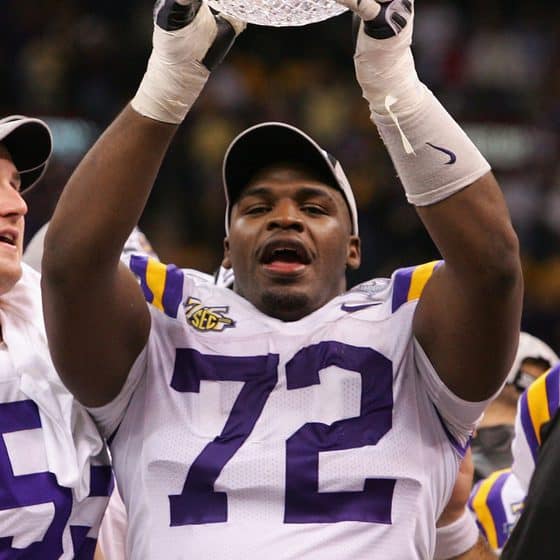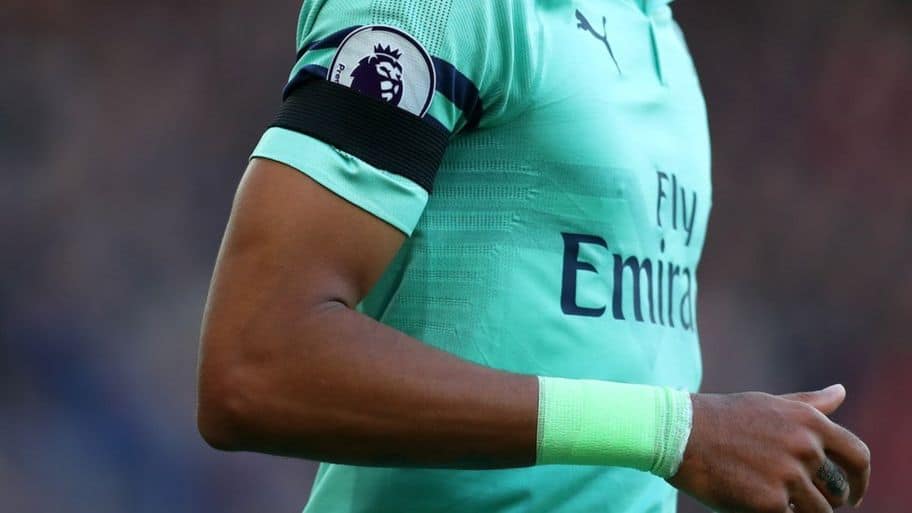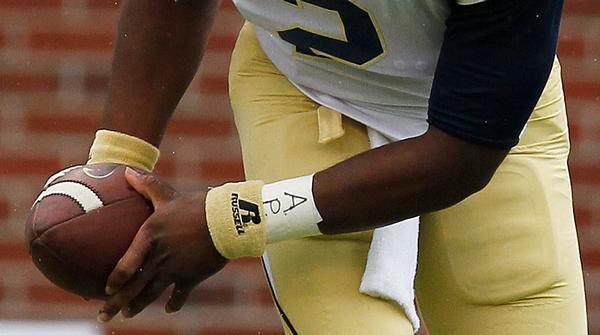Football and soccer players can be seen wearing tape on their wrists during games. Players wear tape on their wrists for a few reasons, which we will highlight throughout this article.
Football players wear tape on their wrists for stability and injury prevention. Football is a contact sport in which players consistently push and pull each other; tape on the wrist helps protect against wrist injuries.
Players will wear athletic tape on their wrists. This type of tape is typically worn around ankles to add support. For the wrists, it’s no different; this tape is tough for hours and still allows players to be flexible enough to move.
Football & Soccer Players Wearing Tape On Their Wrists
Here’s what the athletic tape on the wrist looks like on an athlete:

Wrist Protection
Players wear will athletic tape on their wrists to protect their wrists. In soccer, players are often fighting for ball position, pushing and removing their opponent. Wrists, fingers, and other joints can get pinched or bent the wrong way.
The athletic tape will support the player’s wrists in the case of sudden contact. Soccer players also fall from being slide tackled or getting their shins kicked. When falling, the first reaction is to put the hand down to brace the fall. The wrist can help support any falling action.
Along with general protection from blocking defenders in football or pushing off another player in soccer, soccer goalies can almost always be seen with wrist tape.

The ball traveling at a high velocity will almost always be saved by the goalie’s hands, directly impacting the wrists. Securing the wrist with athletic tape can help lessen the direct impact taken by the soccer ball.
This is the benefit of having stability on the wrists using the tape. Although it’s not going to prevent injuries from happening completely, it does help relieve and support any joints in the wrist.
Hiding Jewelry
Players will use athletic tape to cover up jewelry or any bracelet. Typically, professional leagues do not allow for loose bracelets to be worn; therefore, they will be asked to be removed. Instead of removing the bracelets ( oftentimes, players will elect to keep the bracelets on for superstition reasons), the player will tape over the bracelet.
This way, they can still feel comfortable knowing that they’re wearing the piece of jewelry, but do the referee and the league; it just looks like a piece of tape.
For example, players like Gareth Bale have worn a live-strong bracelet his entire career on his wrist. He’ll often wear tape to cover it up from officials. In his mind, however, he knows he’s still wearing it.
Referees will often stop the game and make players remove any jewelry from their bodies. This is not only for the player’s safety but also for the other players’ safety.
Wrist jewelry, watches, and other small jewelry pieces may get caught on other players, which can, in turn, rip or be altered. It’s much safer to just put a small piece of athletic tape over the wrist to secure the piece of jewelry properly.
See Our Complete List Of Helpful Football Articles Here
Covering Tattoos
Players will sometimes ( not very often) wear tape to cover up tattoos. Often, a player may have a wrist tattoo that they don’t want to show on a national stage to tape over it.
The tape may be small, one over the strip covering up the tattoo, or the player may choose to hide it by putting it over the entire forearm completely. Again, it’s completely up to the player and if the club or team has any policies against it.
As mentioned, this doesn’t happen very often, but it may for players who want to hide it.
Cosmetic Reasons
Players will wear tape on their wrists simply because it looks good—no medical or jewelry reason. If the player enjoys boxing, they may mentally be preparing themselves for a boxing match where they can safely and securely throw their hands.
Other times, players will write the initials of their loved ones or someone who has passed away. We often see this in college and high school football.

The mental state matters when wearing tape, especially for players who use it as a piece of equipment to get themselves locked in and in the zone.
This type of wrist taping with black permanent marker writing is often seen at all levels of football and soccer. High school players can often be seen having forearm tape with the initials of loved ones or small messages to remind them while playing.
The tape can then be ripped off at the end of the game and discarded into a trash barrel.
Healing From An Injury
Last is just healing from an injury. If there was a prior wrist injury, having tape to support the wrist will protect the wrist from bending too far one way or another.
Consult with your team athletic trainer or use the athletic tape found here to ensure the wrist is sustained.
The tape, as mentioned, can provide stability for those who have had wrist injuries. Players with wrist injuries should have trainers’ tape and ensure proper stability.
Players don’t have the technique or the right angle to tape a wrist properly for injury purposes. We always recommend you consult with a professional for injury purposes.
Conclusion
Football and soccer players are both know to wear tape on their wrists during games and matches. The tape on the wrist has specific meanings to that player, both aesthetically and for injury prevention.
Players will wear tape on their wrists for wrist protection, to protect tattoos, to hide jewelry, and to secure an already possible injury.
Having a piece of tape on the wrist is common among athletes and is done for a purpose or a reason.
How do you wear your athletic tape? Do you use it for cosmetic reasons or to help support a prior injury? Let us know in the comment section below!
